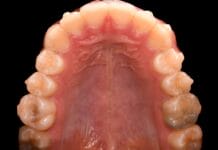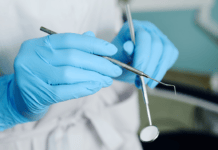1. In general, for patients with prosthetic joint implants, prophylactic antibiotics are not recommended prior to dental procedures to prevent prosthetic joint infection.
In 2014 a panel of experts was convened to review the evidence for or against the use of prophylactic antibiotics in patients with prosthetic joints undergoing dental procedures. The panel found the best evidence failed to demonstrate an association between dental procedures and prosthetic joint infections. Therefore, the current evidence-based clinical practice guidelines state, "In general, for patients with prosthetic joint implants, prophylactic antibiotics are not recommended prior to dental procedures to prevent prosthetic joint infection."
Sollecito, T.P., Abt, E., Lockhart, P.B., et al. The use of prophylactic antibiotics prior to dental procedures in patients with prosthetic joints: Evidence-based clinical practice guideline for dental practitioners--a report of the American Dental Association Council on Scientific Affairs. Journal of the American Dental Association. 2015; 146(1): 11-16.e8. https://doi.org/10.1016/j.adaj.2014.11.012
2. In a case where a patient has a history of complications associated with their joint replacement, prophylactic antibiotics can be considered and discussed with the patient's orthopedic surgeon. If antibiotics are deemed necessary, it is most appropriate for the dentist to provide the regimen and prescription for the antibiotics.
For patients with a history of complications associated with joint replacement, prophylactic antibiotics can be considered; however, consultation with the orthopedic surgeon and patient to determine risks versus benefits should be explored. In the event that prophylactic antibiotics are deemed necessary, "it is most appropriate for the orthopedic surgeon to recommend the appropriate antibiotic regimen and, when reasonable, write the prescription."
Antibiotic Prophylaxis Prior to Dental Procedures. (Last updated: 2022, January 5). American Dental Association. https://www.ada.org/resources/research/science-and-research-institute/oral-health-topics/antibiotic-prophylaxis
3. According to the 2021 American Heart Association's scientific statement, which of the following conditions require prophylactic antibiotics prior to dental treatment?
The American Heart Association lists four high-risk groups requiring prophylactic antibiotics before dental treatment. These include 1) Prosthetic cardiac valve or material, 2) Previous, relapse, or recurrent infective endocarditis, 3) Congenital heart defects, and 4) Cardiac transplant recipients who develop cardiac valvulopathy.
1) Prosthetic cardiac valve or material
Presence of cardiac prosthetic valve, transcatheter implantation of prosthetic valves, cardiac valve repair with devices including annuloplasty, rings or clips, and left ventricular assist devices or implantable heart
2) Previous, relapse, or recurrent infective endocarditis
Patients with a history of infective endocarditis.
3) Congenital heart defects (CHD)
Unrepaired cyanotic congenital CHD, including palliative shunts and conduits, completely repaired CHD with prosthetic material or device, whether placed by surgery or by transcatheter during the first 6 months after the procedure, repaired CHD with residual defects at the site of or adjacent to the site of a prosthetic patch or device, surgical or transcatheter pulmonary artery valve or conduit placement such as a Melody valve and Contegra conduit.
4) Cardiac transplant recipients who develop cardiac valvulopathy
Patients with heart transplants and no reported complications are not required to use prophylactic antibiotics prior to dental treatment.
Wilson, W.R., Gewitz, M., Lockhart, P.B., et al. Prevention of Viridans Group Streptococcal Infective Endocarditis: A Scientific Statement from the American Heart Association. Circulation. 2021; 143(20): e963–e978. https://doi.org/10.1161/CIR.0000000000000969
4. Due to an increased risk of infection, patients with breast implants should use prophylactic antibiotics prior to dental treatment.
Based on current evidence, it is not recommended that patients with breast implants use prophylactic antibiotics before invasive or non-invasive dental treatment. The only exception is in the case of a patient that has a history of complications after breast augmentation. Additionally, if prophylactic antibiotics are recommended, the patient's surgeon should determine the regimen and provide the prescription for the antibiotics.
Stoopler, E.T., Sia, Y.W., Kuperstein, A.S. Do patients with solid organ transplants or breast implants require antibiotic prophylaxis before dental treatment? J Can Dent Assoc. 2012; 78: c5. https://jcda.ca/article/c5
5. The evolution of guidelines as more evidence is available has changed drastically. What year was the first official recommendation of prophylactic antibiotic use prior to dental treatment established?
In 1955, the American Heart Association recommended: "intramuscular benzylpenicillin for all patients at risk." Since then, recommendations for prophylactic antibiotic use prior to dental treatment have progressively decreased. Different countries have different recommendations as well.
Evolution of guidelines for endocarditis prophylaxis
Year: 1955
- Organization: American Heart Association
- Recommendation (patients without penicillin hypersensitivity): Intramuscular benzylpenicillin for all patients at risk
Year: 1982
- Organization: British Society for Antimicrobial Chemotherapy
- Recommendation (patients without penicillin hypersensitivity): Oral amoxicillin, 3 g one hour before treatment, 1.5 g six hours after treatment
Year: 1997
- Organization: American Heart Association
- Recommendation (patients without penicillin hypersensitivity): Oral amoxicillin, 2 g one hour before treatment
Year: 2007
- Organization: American Heart Association
- Recommendation (patients without penicillin hypersensitivity): Prophylaxis limited to high-risk patients
Year: 2008
- Organization: National Institute for Health and Clinical Excellence (UK)
- Recommendation (patients without penicillin hypersensitivity): No antibiotic prophylaxis
Daly, C.G. Antibiotic prophylaxis for dental procedures. Australian Prescriber. 2017; 40(5): 184-188. https://doi.org/10.18773/austprescr.2017.054
6. C. difficile infection is a concern when prescribing antibiotics. Patients that are 65 and older are at a higher risk of developing C. difficile infections.
Clostridium difficile infections are increasing in prevalence and severity, with 44% of cases considered to be "community-associated" of these, 65% have been determined to occur after antibiotic use. C. difficile infection sequelae can range from mild to life-threatening, including pseudomembranous colitis, toxic megacolon, colon perforation, sepsis, and in rare cases, death.
Antibiotic Stewardship. (Last updated: 2020, September 29). American Dental Association. https://www.ada.org/resources/research/science-and-research-institute/oral-health-topics/antibiotic-stewardship
7. For individuals at high risk of infective endocarditis, the American Heart Association recommends prophylactic antibiotics be taken 30-60 minutes prior to dental procedures. If the patient forgets to take their antibiotics, they should be dismissed without treatment.
The American Heart Association recommends prophylactic antibiotics be taken 30-60 minutes before dental treatment; however, they can be taken up to 2 hours after dental procedures. This allows patients to be treated and follow up with their antibiotic regimen safely without increased risk of developing infective endocarditis.
Antibiotic Prophylaxis for Dental Patients at Risk for Infection. (2022). American Academy of Pediatric Dentistry. https://www.aapd.org/media/Policies_Guidelines/BP_Prophylaxis.pdf








